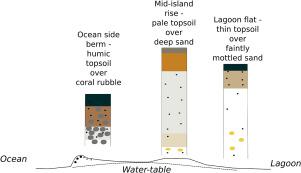Geoderma Regional ( IF 3.1 ) Pub Date : 2021-05-11 , DOI: 10.1016/j.geodrs.2021.e00391 I.C. Baillie , C.N. Floyd , S.H. Hallett , R. Andrews

|
We conducted soil surveys on two islands in the Peros Banhos and Salomon atolls of the northern Chagos Archipelago, Indian Ocean. We found muted but consistent topographic and soil zonation from the ocean shores to the lagoons. The main elements of the zonation are: berms of coral boulders and rubble along the heads of the ocean-side beaches; rubble-strewn soils inland of the berm; and pale sands with shallower topsoils and few coral clasts on slight rises and declivities over the rest of the islands. The ocean-side rubbly soils have interstitial coarse sand and are the most fertile on the islands, with dense tangled stands of unmanaged coconuts, profuse litter, and deep humic topsoils. Topsoils are shallower and less humic in the pale sands inland. Sand size decreases from ocean to lagoon, but increases with depth in most profiles. Water tables are often <2 m deep, and many soils have faint pale brownish mottling in the lower subsoils. There is a low tabular outcrop of bare Holocene coral sandstone on one of the islands. It is incised by shallow grikes that are partly infilled with silty muck, as are some small depressions in the central parts of both islands. The pedogenic environment appears to be dynamic, with storm surges depositing fresh sand, eroding coastlines, and infilling inter-island channels. Some soils have buried humic topsoils, stone layers, sand size inversions, and slight changes in sand colour, which are attributed to polycyclic pedogenesis. Some topsoils have elevated levels of total Zn, which is thought to be derived from long distance volcanic ash. Our data indicate that the soils are of low nutrient fertility. Total N and available P do not attain the strikingly eutric levels found in some atoll soils. The low fertility is attributed to the predation of seabirds by inadvertently introduced black rats. This precludes soil enrichment with marine-derived nutrients by guano deposition.
中文翻译:

印度洋查戈斯群岛北部环礁的地形区划和多环成岩作用
我们在印度洋北部查戈斯群岛的佩罗斯Banhos和所罗门环礁的两个岛屿上进行了土壤调查。我们发现从大洋彼岸到泻湖的地形和土壤分区保持不变,但保持一致。分区的主要内容是:沿着海边沙滩的顶部长有珊瑚巨石和碎石的护堤;护堤内陆的碎石土壤;岛上其他地区则是浅沙,表层土壤较浅,珊瑚屑很少,略有上升和下降。海边的泥土具有间隙性的粗砂,是岛上最肥沃的土壤,密密的纠结着未处理的椰子,大量的凋落物和深厚的腐殖土。内陆浅沙中的表层土壤较浅,腐殖质较少。从海洋到泻湖,沙粒尺寸减小,但在大多数剖面中,沙粒尺寸随深度增加。地下水位通常<2 m深,许多土壤在下层土壤中微弱地呈浅褐色斑点。在其中一个岛屿上,裸露的全新世珊瑚砂岩的板状露头较低。它由浅层砂砾切割而成,浅层砂砾部分填充有粉质碎屑,两个岛屿中部的一些小洼地也是如此。成岩环境似乎是动态的,风暴潮沉积了新鲜的沙子,侵蚀了海岸线,并充斥了岛际通道。一些土壤埋有腐殖质表层土壤,石层,沙子尺寸倒置和沙子颜色略有变化,这归因于多环成岩作用。一些表层土壤的总锌含量升高,据认为这是由于长距离火山灰产生的。我们的数据表明土壤的养分含量较低。总氮和有效磷不能达到某些环礁土壤中的极富营养水平。低繁殖力归因于无意引入的黑鼠捕食海鸟。这排除了通过鸟粪沉积使海洋来源的养分富集土壤的可能性。











































 京公网安备 11010802027423号
京公网安备 11010802027423号